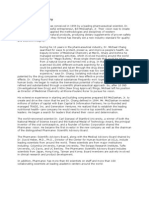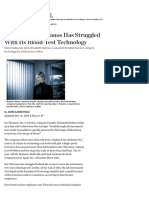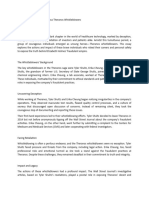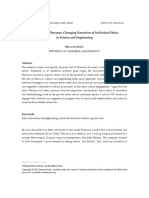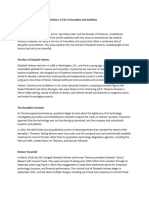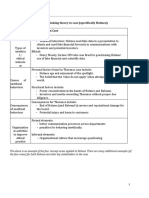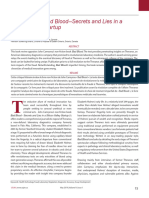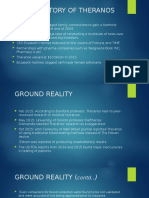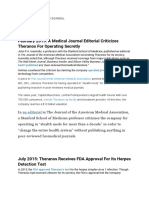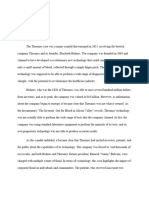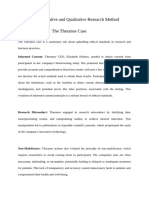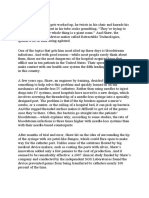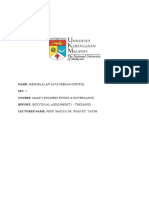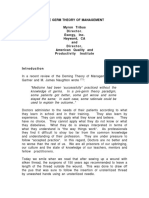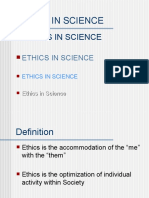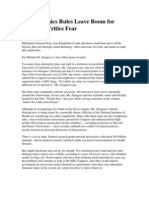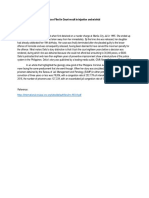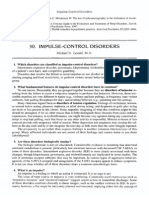Theranos Company Background
Theranos Company Background
Uploaded by
Christine CuteCopyright:
Available Formats
Theranos Company Background
Theranos Company Background
Uploaded by
Christine CuteOriginal Title
Copyright
Available Formats
Share this document
Did you find this document useful?
Is this content inappropriate?
Copyright:
Available Formats
Theranos Company Background
Theranos Company Background
Uploaded by
Christine CuteCopyright:
Available Formats
Theranos
Company Background
Theranos which derived from the word “therapy” and “diagnosis” was a privately
held health technology corporation based on America. It was initially touted as a
breakthrough technology company, with claims to have revolutionized blood testing.
The company offers more than 240 tests, ranging from cholesterol to cancer that
requires only a very small amounts of blood, such as from a finger prick and could be
performed using small automated devices the company had developed within just a
short period of time compared to the traditional blood testing that may take longer hours
up to several days to get the results. Holmes believes that providing faster, more
convenient, and cheaper access to lab tests will transform preventive medicine. At
Theranos, they never charges more than half the rate set by Medicare for blood tests
which is really way cheaper. For an instance, a test for HIV which cost more than $80,
at Theranos, they only charges $16.56.
The company was founded in 2003 when Elizabeth Holmes is just 19 years old. In 2013
and 2014, Theranos soared in valuation that raised more than US$700 million from
venture capitalists and private investors, resulting in a $10 billion valuation at its peak.
Theranos headquarter was in Palo Alto, California and had laboratories in Newark,
California and Scottsdale, Arizona.
Elizabeth Anne Holmes was an American businesswoman who was born February 3,
1984 in Washington, D.C. She was the founder and CEO of Theranos, a health
technology company that aims to revolutionized blood testing.
In 2002, she attended Stanford's School of Engineering, where she took chemical
engineering. Then she worked as a student researcher and a laboratory assistant in
the School of Engineering. By the time she got in in Stanford, Holmes knew she wanted
to devote her life working in on health care. At Stanford, she'd been exploring lab-on-a-
chip technology, which allows diverse results to be extracted from a minuscule amount
of liquid on a microchip. She became a “president’s scholar” during her freshman year
which came with a $3,000 allowance for her research project. After the end of her
freshman year, during summer, Holmes started working in a laboratory at the Genome
Institute of Singapore and tested for severe acute respiratory syndrome
coronavirus (SARS-CoV-1) by collecting blood samples with syringes.
In 2003, she then filed her first patent application for a “medical device for analyte
monitoring and drug delivery” a wearable drug-delivery patch that would administer
medication, monitor’s patients’ blood, adjust the dosage needed and update doctors
wirelessly.
In March 2004, she dropped out of Stanford's School of Engineering and used her
tuition money as her capital fund for a consumer healthcare technology company.
Holmes named her company “Real-Time Cures” and it is located in Palo Alto, California
to "democratize healthcare" she said. According to Holmes, her fear of needles is what
drives her to perform blood tests by only using a small amounts of blood. When Holmes
initially pitched this idea of "vast amounts of data from a few droplets of blood derived
from the tip of a finger" to her medicine professor at Stanford, Phyllis Gardner, he
responded with "I don't think your idea is going to work", explaining how it was
impossible to accomplish despite Holmes claiming that it could be done. Aside from
Gardner, several other expert medical professors told Holmes the same exact
thing. However, Holmes did not allow their opinions to stop her from believing that it was
possible. Later on, she succeeded in getting her advisor and dean at the School of
Engineering, Channing Robertson, to back up her idea.
You might also like
- A Case Study of The Leadership of Elizabeth HolmesNo ratings yetA Case Study of The Leadership of Elizabeth Holmes3 pages
- TERM PAPER On SMALL BUSINESS IDEAS AND OPPORTUNITIES in BDNo ratings yetTERM PAPER On SMALL BUSINESS IDEAS AND OPPORTUNITIES in BD20 pages
- One Woman's Drive To Revolutionize Medical Testing The New YorkerNo ratings yetOne Woman's Drive To Revolutionize Medical Testing The New Yorker13 pages
- Hot Startup Theranos Has Struggled With Its Blood-Test Technology - WSJ100% (1)Hot Startup Theranos Has Struggled With Its Blood-Test Technology - WSJ11 pages
- Growth Story of Theranos and Holmes: Harsh RealityNo ratings yetGrowth Story of Theranos and Holmes: Harsh Reality2 pages
- Biotech's Theranos Offers A Cautionary Tale For Silicon ValleyNo ratings yetBiotech's Theranos Offers A Cautionary Tale For Silicon Valley3 pages
- Application of Iot in Radisson Hotel GroupNo ratings yetApplication of Iot in Radisson Hotel Group17 pages
- Lessons From Theranos: Changing Narratives of Individual Ethics in Science and EngineeringNo ratings yetLessons From Theranos: Changing Narratives of Individual Ethics in Science and Engineering6 pages
- Bad Blood: Secrets and Lies in a Silicon Valley Startup by John Carreyrou | Conversation StartersFrom EverandBad Blood: Secrets and Lies in a Silicon Valley Startup by John Carreyrou | Conversation StartersNo ratings yet
- Theranos and Elizabeth Holmes Charged With Fraud - Scientific AmericanNo ratings yetTheranos and Elizabeth Holmes Charged With Fraud - Scientific American8 pages
- Theranos Toxic Leaders Case For StudentsNo ratings yetTheranos Toxic Leaders Case For Students7 pages
- Book_Review_Bad_Blood_-_Secrets_and_Lies_in_a_SiliNo ratings yetBook_Review_Bad_Blood_-_Secrets_and_Lies_in_a_Sili2 pages
- February 2015: A Medical Journal Editorial Criticizes Theranos For Operating SecretlyNo ratings yetFebruary 2015: A Medical Journal Editorial Criticizes Theranos For Operating Secretly6 pages
- Bad Blood - Summarized for Busy People: Secrets and Lies in a Silicon Valley Startup: Based on the Book by John CarreyrouFrom EverandBad Blood - Summarized for Busy People: Secrets and Lies in a Silicon Valley Startup: Based on the Book by John Carreyrou4.5/5 (3)
- Argument Paper MC Johnson - Animal TestingNo ratings yetArgument Paper MC Johnson - Animal Testing8 pages
- @MBS MedicalBooksStore 2019 Management PDF100% (2)@MBS MedicalBooksStore 2019 Management PDF310 pages
- The Body Hunters: Testing New Drugs on the World's Poorest PatientsFrom EverandThe Body Hunters: Testing New Drugs on the World's Poorest PatientsNo ratings yet
- Drugs and Drugs 2nd Edition Dr. Peter Hamilton 2024 Scribd DownloadNo ratings yetDrugs and Drugs 2nd Edition Dr. Peter Hamilton 2024 Scribd Download51 pages
- Harrison’s Hematology and Oncology 3rd Edition Dan L. Longo All Chapters Instant Download100% (4)Harrison’s Hematology and Oncology 3rd Edition Dan L. Longo All Chapters Instant Download66 pages
- Evidence Based Medicine Needs A Reality Check - R - 4No ratings yetEvidence Based Medicine Needs A Reality Check - R - 46 pages
- Harrison’s Hematology and Oncology 3rd Edition Dan L. Longo All Chapters Instant Download100% (1)Harrison’s Hematology and Oncology 3rd Edition Dan L. Longo All Chapters Instant Download46 pages
- M. 18 Upper Limb Clinical Correlations (Dr-Laygo) (10-26-18)No ratings yetM. 18 Upper Limb Clinical Correlations (Dr-Laygo) (10-26-18)8 pages
- Case Filed in Court Result in Injustice and MistrialNo ratings yetCase Filed in Court Result in Injustice and Mistrial2 pages
- 1756-Ib32, 1756-Ib32K: Controllogix DC (10 31.2V) Input ModuleNo ratings yet1756-Ib32, 1756-Ib32K: Controllogix DC (10 31.2V) Input Module3 pages
- Inert Gas: Sugar Grape Must Alcohol Carbonic Maceration Beaujolais Storage Nitrogen ArgonNo ratings yetInert Gas: Sugar Grape Must Alcohol Carbonic Maceration Beaujolais Storage Nitrogen Argon1 page
- TS RE 023 Road Transport Traffic Telematics and Ancillary EquipmentNo ratings yetTS RE 023 Road Transport Traffic Telematics and Ancillary Equipment5 pages
- Full Download Functional Performance in Older Adults Fourth Edition Bette R. Bonder PDF DOCX100% (2)Full Download Functional Performance in Older Adults Fourth Edition Bette R. Bonder PDF DOCX51 pages
- Josef Mengele, Angel of Death,: WWW - Auschwitz.dk/mengele - HTMNo ratings yetJosef Mengele, Angel of Death,: WWW - Auschwitz.dk/mengele - HTM6 pages
- OUI ROI FINAL 20210219 Redacted - RedactedNo ratings yetOUI ROI FINAL 20210219 Redacted - Redacted47 pages




